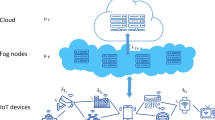Abstract
The dew computing paradigm is emerging as a complement of cloud computing to cover its limitations. Independence is one of the essential features of dew computing. It means that it can continue to provide services without an Internet connection. These characteristics of dew computing allow it to find a niche in real-time applications. The importance of real-time applications in daily human life is not hidden due to the growing development of the Internet of Things. In this paper, the hierarchical architecture of cloud-fog-dew is presented to overcome the limitations of cloud computing in real-time applications such as latency and resource management. Also, a Mixed Integer Non-Linear Programming model is presented for the scheduling of real-time applications in the proposed architecture. It aims to reduce power consumption and Internet traffic. Besides, the proposed model is supported by Non-dominated Sorting Genetic Algorithm II to provide scalability. The simulation results demonstrate that completing tasks in the dew computing layer can reduce Internet dependency while also reducing power consumption and traffic. As a result, under the suggested paradigm, the number of tasks missed due to stoppage or Internet disturbance is reduced.












Similar content being viewed by others
References
Biswas AR, Giaffreda R (2014) IoT and cloud convergence: opportunities and challenges. IEEE world forum on Internet of Things (WF-IoT), pp 375–376
Malik A, Om H (2018) Cloud computing and Internet of Things integration: architecture, applications, issues, and challenges. In: Rivera W (ed) Sustainable cloud and energy services. Springer, pp 1–24
Zanella A, Bui N, Castellani A, Vangelista L, Zorzi M (2014) Internet of Things for smart cities. IEEE Int Things J 1(1):22–32
Hu P, Dhelim S, Ning H, Qiu T (2017) Survey on fog computing: architecture key technologies, applications, and open issues. J Netw Comput Appl. https://doi.org/10.1016/j.jnca.2017.09.002
Javadzadeh G, Rahmani AM (2019) Fog computing applications in smart cities: a systematic survey. Wirel Netw. https://doi.org/10.1007/s11276-019-02208-y
Ray PP (2018) Minimizing dependency on Internetwork: Is dew computing a solution? Trans Emerg Telecom Technol. https://doi.org/10.1002/ett.3496
Deng R, Lu R, Lai C (2016) Optimal workload allocation in fog-cloud computing towards balanced delay and power consumption. IEEE Internet Things J 3(6):1171–1181
Sojat Z, Skala K (2016) Views on the role and importance of dew computing in the service and control technology, In: 2016 39th international convention on information and communication technology, electronics and microelectronics (MIPRO)
Ray PP (2018) An introduction to dew computing: definition concept and implications. IEEE Access 6:723–737
Hirsch M, Mateos C, Zunino A, Majchrzak TA, Gronli TM, Kaindl H (2021) A simulation-based performance evaluation of heuristics for dew computing, In: Proceedings of the 54th Hawaii international conference on system sciences, Hawaii, pp 7207
Verma P, Fatima S (2020) Smart healthcare applications and real-time analytics through edge computing. In: Raj P, Chatterjee JM, Kumar A, Balamurugan B (eds) Internet of Things use cases for healthcare industry. Springer, pp 241–270
Tychalas D, Karatza H (2020) A scheduling algorithm for fog computing system with bag-of-tasks jobs: simulation and performance evaluation. Simul Model Pract Theory. https://doi.org/10.1016/j.simpat.2019.101982
Stavrinides GL, Karatza HD (2019) An energy-efficient QoS-aware and cost-effective scheduling approach for real-time workflow applications in cloud computing systems utilizing DVFS and approximate computations. Future Gener Comput Syst 96:216–226
Elavarasi R, Silas S (2019) Survey on job scheduling in fog computing, In: Proceedings of third international conference on trends in electronics and informatics (ICOEI - IEEE)
Alizadeh MR, Khajehvand V, Rahmani AM, Akbari E (2020) Task scheduling approaches in fog computing: a systematic review. Commun Syst. https://doi.org/10.1002/dac.4583
Skala K, Davidovic D, Afgan E, Sovic I, Sojat A (2015) Scalable distributed computing hierarchy: cloud, fog and dew computing. Open J Cloud Comput (OJCC) 2(1):16–24
Hiral MP, Rupal RC, Prajapati KR, Patel AA (2018) The independent part of cloud computing: Dew computing. In: Hu YC, Tiwari S, Mishra KK, Trivedi MC (eds) Intelligent communication and computational technologies. Springer Singapore, pp 345–355
Abdoos M, Taheri H, Taeezadeh A (2019) A proposed computation, which benefits from the cooperation of dew, edge, andcloud computation. Trans Emerg Telecommun Technol. https://doi.org/10.1002/ett.3796
Cardellini V, Grassi V, Presti FL, Nardelli M (2015) On QoS-aware scheduling of data stream applications over fog computing infrastructures. In: IEEE symposium on computers and communication
Ray PP, Dash D, De D (2018) Internet of Things-based real-time model study on e-healthcare: device, message service and dew computing, computer networks
Choudhari T, Moh M, Moh TS (2018) Prioritized task scheduling in fog computing. In: proceedings of the ACMSE 18 conference
Hirsch M, Mateos C, Zunino A, Majchrzak TA, Gronli TM, Kaindl H (2021) A task execution scheme for Dew computing with State-of-the-Art Smartphones. Electronics. https://doi.org/10.3390/electronics10162006
Hossain Khan MS, Roy P, Khanam F, Hera FH, Das AK (2019) An efficient resource allocation mechanism for time-sensitive data in Dew computing, In: international conference of artificial intelligence and information technology (ICAIIT), pp 506–510
Sahinidis NV (2019) Mixed-integer nonlinear programming 2018. Optim Eng 20:301–306
IEEE 1934–2018 (2018) IEEE standard for adoption of openfog reference architecture for fog computing. 102: 1369–1385
Gupta BB, Quamara M (2018) An overview of Internet of Things IoT): architectural aspects, challenges, and protocols. Concurr Comput Pract Exp. https://doi.org/10.1002/cpe.4946
Kasana HS, Kumar KD (2004) The simplex algorithm, Introductory operations, Springer, pp 63-105
Bussieck MR, Meeraus A (2004) General algebric modeling system (GAMS). In: Kallrath J (ed) Modeling languages in mathematical optimization. Springer, pp 137–157
Ghildyal V, Sahinidis NV (2001) Solving global optimization problems with baron. In: Migdalas A, Pardalos PM, Värbrand P (eds) From local to global optimization. Springer, pp 205–230
Author information
Authors and Affiliations
Corresponding author
Additional information
Publisher's Note
Springer Nature remains neutral with regard to jurisdictional claims in published maps and institutional affiliations.
Rights and permissions
About this article
Cite this article
Javadzadeh, G., Rahmani, A.M. & Kamarposhti, M.S. Mathematical model for the scheduling of real-time applications in IoT using Dew computing. J Supercomput 78, 7464–7488 (2022). https://doi.org/10.1007/s11227-021-04170-z
Accepted:
Published:
Issue Date:
DOI: https://doi.org/10.1007/s11227-021-04170-z




